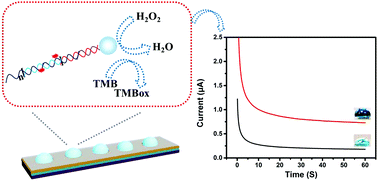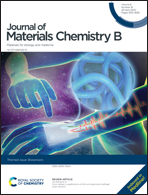A colorimetric and electrochemical dual-mode biosensor for thrombin using a magnetic separation technique†
Abstract
In general, protein detection relies primarily on enzyme-linked immunosorbent assays. Here, we constructed a colorimetric and electrochemical dual-mode biosensor for thrombin detection based on the mechanism of aptamer recognition. Magnetic nanobeads (MBs) were used as carriers for separation and enrichment to quickly capture thrombin (TB) in the complex matrix. Also, the combination of MBs and the magnetic electrode array (MEA) effectively avoided the poisoning of the electrode by biological samples. Furthermore, hybridization chain reaction (HCR) was indirectly used to achieve amplification of TB. A large number of horseradish peroxidases (HRPs) were coupled with the amplified long nucleic acid fragments. Based on the color and current response of the substrate TMB catalyzed by HRP, a dual-mode detection system for thrombin was established to ensure the accuracy of the test results. The method had a minimum resolution of 10 nM to the naked eye and an electrochemical detection limit as low as 0.35 nM. In addition, the sensor provided good anti-interference ability in a complex matrix and showed great potential to detect TB in complex samples.

- This article is part of the themed collections: Journal of Materials Chemistry B Lunar New Year collection 2021 and Biosensors


 Please wait while we load your content...
Please wait while we load your content...